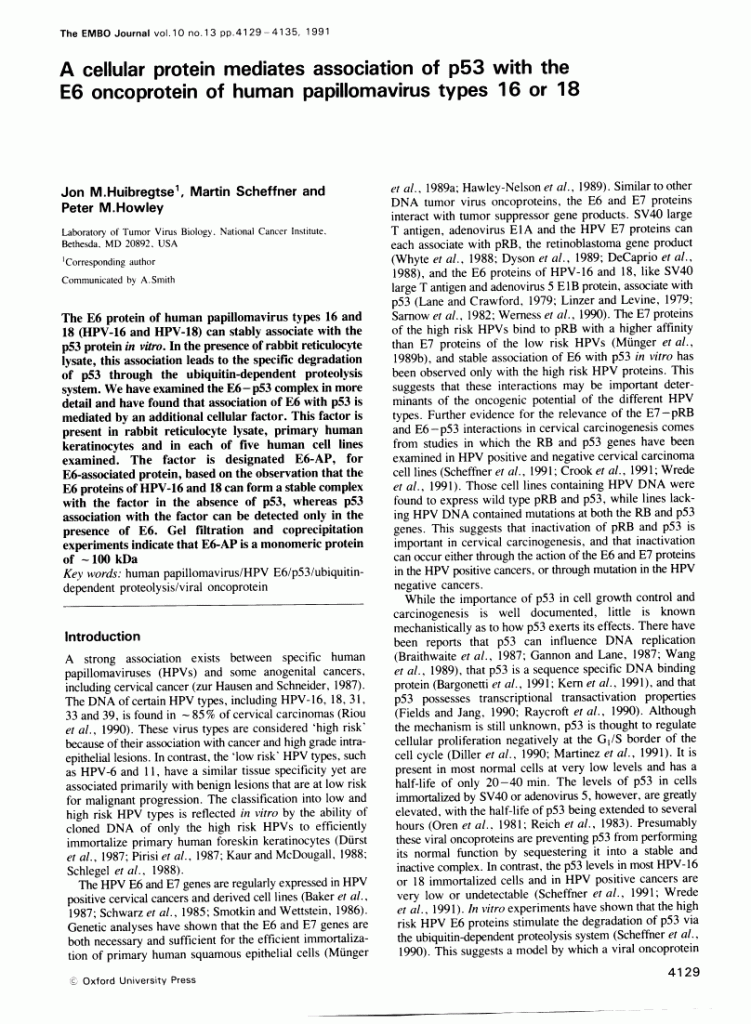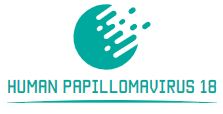The E6 protein of human papillomavirus types 16 and 18 (HPV-16 and HPV-18) can stably affiliate with the p53 protein in vitro. In the presence of rabbit reticulocyte lysate, this association results in the particular degradation of p53 via the ubiquitin-dependent proteolysis system.
We have examined the E6-p53 advanced in additional element and have discovered that association of E6 with p53 is mediated by an extra cellular issue. This issue is current in rabbit reticulocyte lysate, main human keratinocytes and in every of 5 human cell strains examined.
The issue is designated E6-AP, for E6-associated protein, based mostly on the statement that the E6 proteins of HPV-16 and 18 can kind a steady advanced with the think about the absence of p53, whereas p53 association with the issue will be detected solely in the presence of E6. Gel filtration and coprecipitation experiments point out that E6-AP is a monomeric protein of roughly 100 kDa.

The elevated 10-year threat of cervical precancer and most cancers in girls with human papillomavirus (HPV) kind 16 or 18 and the doable utility of type-specific HPV testing in medical follow.
BACKGROUNDHuman papillomavirus (HPV) types 16 and 18 trigger 60%-70% of cervical most cancers worldwide, and different HPV types trigger nearly all remaining circumstances. Pooled HPV testing for 13 oncogenic types, together with HPV16 and 18, is at the moment utilized in medical follow for triage of equivocal cytology and, in conjunction with Pap checks, is an choice for normal screening amongst girls 30 years of age and older.
It isn’t clear to what extent particular person identification of HPV16 or HPV18 as an adjunct to pooled oncogenic HPV testing may successfully establish girls at notably excessive threat of cervical most cancers or its instant precursor, cervical intraepithelial neoplasia 3 (CIN3).
METHODSFrom April 1, 1989, to November 2, 1990, a complete of 20 810 girls in the Kaiser Permanente well being plan in Portland, OR, enrolled in a cohort examine of HPV and cervical neoplasia. Women have been examined for 13 oncogenic HPV types by Hybrid Capture 2 (HC2), and people girls with a optimistic HC2 take a look at have been examined for HPV16 and 18.
Enrollment Pap smear interpretation and HPV take a look at outcomes have been linked to histologically confirmed CIN3 and cervical most cancers >> or = CIN3) occurring throughout 10 years of cytologic follow-up. We calculated cumulative incidence charges with 95% confidence intervals for every interval as much as 122 months utilizing Kaplan-Meier strategies.
RESULTSThe 10-year cumulative incidence charges of>> or = CIN3 have been 17.2% (95% confidence interval [CI] = 11.5% to 22.9%) amongst HPV16+ girls and 13.6% (95% CI = 3.6% to 23.7%) amongst HPV18+ (HPV16-) girls, however solely 3.0% (95% CI = 1.9% to 4.2%) amongst HC2+ girls destructive for HPV16 or HPV18. The 10-year cumulative incidence amongst HC2- girls was 0.8% (95% CI = 0.6% to 1.1%).
A subanalysis amongst girls 30 years of age and older with regular cytology at enrollment strengthened the noticed threat variations.CONCLUSIONSHPV screening that distinguishes HPV16 and HPV18 from different oncogenic HPV types might establish girls at the biggest threat of>> or = CIN3 and will allow much less aggressive administration of different girls with oncogenic HPV infections.
